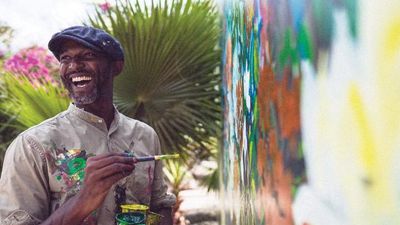On the Caribbean’s Dutch Island of Curaçao, the Emerging Art Scene Is as Colorful as the Scenery
THERE’S A MYSTIQUE about the Netherlands-affiliated island state of Curaçao, one of the three ABC Islands in the Caribbean just off the coast of Venezuela. (The others are Aruba and Bonaire.) Gleaming white beaches and clear turquoise waters in the shadows of towering cliffs dotted with centuries-old forts may come to mind, and historic downtowns with tall skinny candy-colored buildings. All that is, of course, a major draw. Increasingly, so is art.
On Curaçao, scooter tours are available, which might take you over the Queen Emma Floating Bridge into the heart of the Willemstad district. This is where murals abound, and painters work in open-air bazaars down alleyways, and local personalities like Francis Sling hold forth. Sling, also a popular singer and poet, creates intricate, color-drenched portraits and depictions of island flora on buildings and on canvases in his breezy gallery.
You need a tour guide to catch all the varied art to be found in other nooks and crannies on the island. There is, for example, the museum-shop dedicated to the recently departed former beauty queen Nena Sanchez, set up in the Landhuis Jan Kok — an 1840s plantation house across the street from a shallow salt lake where pink flamingos come to dine on tiny shrimp. Sanchez’s sophisticated blue-hued women with flowers in their hair are famous around here.
And there’s the cultural center at Landhuis Bloemhof, on whose grounds you find not only a crisp gallery space, but also an entire walk-thru installation called the Cathedral of Thorns, made of the dried branches of a prickly island shrub — and a fab garden-side café called Number Ten, where the avocado toast comes with fennel seeds and chili flakes. Also, you can head to Serena’s Art Factory to paint your own chichi, a bulbous little statuette of an ebullient big sister that, with its no-two-are-alike mad swirls of color, has become an unofficial symbol of Curaçao.
You might even get an art class, over wine and a dinner of — wait for it —Texas barbecue (an increasingly popular delicacy on the island) in the garden of yet another sprawling former plantation house. Landuis Jan Thiel was built in the 1700s, and Remy Bernabela, a retired pro cyclist, will bring his pit and cook up a truly accomplished spread of brisket, turkey, sausage and pit-roasted sweet potatoes.
Curaçao's Tugboat Beach
A cute corner at Number Ten
Beachfront at the Papagayo
Other adventures du jour on Curaçao include freediving with a Seabob, a bit like a small handheld jet ski that helps you go a little deeper and faster, so you can get close to the namesake shipwreck at Tugboat Beach. An outfit called Bearded Butlers can set you up; the proprietor is as patient as he is handsome if it takes you a minute to get the hang of it.
Speaking of unique beaches, there’s the sparkling Playa Kenepa Grandi, kind of a local secret, as notable for its sweeping rocky vistas as its nearby military base that routinely delivers throngs of young hunks on break to cavort. (No kidding, it’s like a photo shoot for one of those steamy hunk-of-the-month calendars over here.)
The nightlife seeker may find his way to the Peitermaai district, where cool bars — often presented in a hiply tattered baroque style — are hidden down alleyways. The one called Mundo Bizaro is popular these days.
Lodging options span the Renaissance Curaçao Wind Creek Resort — a family-friendly affair near where massive cruise ships dock, with a lovely patio through which iguanas saunter during breakfast — to the decidedly more contemporary and minimalist Papagayo Beach Hotel. Insanely beautiful thirtysomething Dutch couples must get a great discount at Papagayo; they’re everywhere.
Memorable dining options in Curaçao include Restaurant Gouveneur de Rouville, a rambling old building with a Pat O’Brien’s energy, yet another pretty crowd, and views of the harbor and Governor’s Palace. The menu features Keshi Yena, a classic dish of shredded chicken, encased in cheese and baked, that’s said to date to the cooking of African slaves hundreds of years ago. At mod poolside Nultwintig (which means 020, the area code for Amsterdam) well-scrubbed Europeans enjoy truffled pumpkin risotto — and grab their silverware from the silverware drawers conveniently hidden away right there at the table.
The people-watching is divine, and that might be the best art of all.
- Travel - Houston CityBook ›
- Iconic Gallery Reopens for One Month Only, with Fine Art Available at a Steal - Houston CityBook ›
